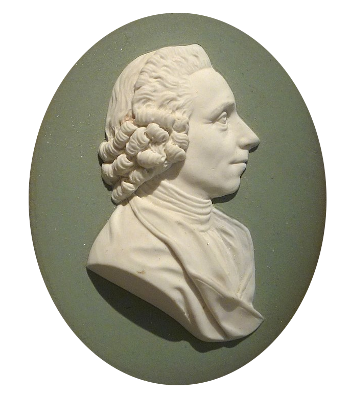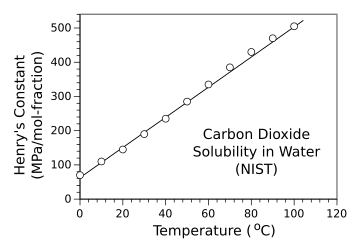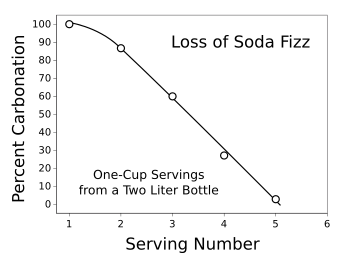Soda Fizz
September 27, 2021
Chemists have advanced our
quality of life in many ways, and among the
products of their
research are the
carbonated beverages that we enjoy on nearly a daily basis.
English chemist,
Joseph Priestley (1733-1804), created the first batch of
carbonated water in 1767 by suspending a container of
distilled water above a
beer vat at a
brewery.
Fermentation produces
carbon dioxide, which was known to Priestley as fixed air, as a
product. He later improved his process by using the
reaction of
sulfuric acid and
chalk (
calcium carbonate) to produce carbon dioxide
gas.
Shortly thereafter,
Johann Jacob Schweppe (1740-1821) used a similar process to produce carbonated
mineral water. His
Schweppes Company was founded in
Geneva in 1783, and then relocated to
London in 1792. Schweppes was designated the official drink supplier of the
Great Exhibition of 1851 in London. Among the million
bottles of
soft drinks such as
lemonade and
ginger beer, sold at the Great Exhibition were many bottles of the carbonated drinks,
seltzer water and
soda-water. Today's
global market for carbonated soft drink has an estimated value of 221.6 billion
dollars.

Joseph Priestley (1733-1804).
Priestley's fame derives mostly from his discoveries of several gases, notably oxygen, which Priestley called "dephlogisticated air". The name derives from the phlogiston theory, and Priestley's belief in this theory after much evidence to the contrary caused him to become isolated from the scientific community.
Priestley's politics, which included support of the French Revolution, forced his exile from England in 1791 to Pennsylvania after a mob burned his Birmingham home.
(Priestley, commemorated in Wedgewood china, exhibited at the Chazen Museum of Art, University of Wisconsin-Madison (Madison, Wisconsin). Photo by Daderot via Wikimedia Commons
Progress in
chemistry also has its
history of
unintended consequences, as the
ozone hole and
global warming have taught us. One problem with most carbonated beverages is their high
sugar content, which is about 40
grams in a 12
ounce serving. This amount actually exceeds the daily added sugar allowance for an
adult male recommended by many
health agencies. Many people, myself included, now drink
diet soft drinks, but these represent just a quarter (by
volume) of the total
market. Alas, I don't have a
Diet Coke button on my desk, but I prefer
Pepsi Zero, instead.
We should be thankful for the many choices of
artificial sweeteners available today. I wrote about some of these in an
earlier article (Insecticidal Sweeteners, August 11, 2016). These are much better than the artificial sweeteners of my
youth, which were quite awful. The older sweeteners were occasionally suspected to be
toxic, at least in studies on
laboratory rats. Such was the case for
sodium cyclamate, which was
banned in the
United States in 1970 after being found to cause
bladder cancer in rats at high
dosage. Later studies revealed that
humans did not appear to have the same problem, but cyclamates are still banned in the US.
The
scientific study of gases in
liquids, among which were the
solubility of carbon dioxide in
water, followed the initial work by Priestley. Fellow English chemist,
William Henry (1774-1836) formulated the
eponymous Henry's law that states that the quantity of dissolved gas in a liquid is
proportional to its
partial pressure above the liquid;[1] viz.,

or

in which
c is the
concentration,
p is the partial pressure, and the proportionality factors
Hcp and
Hpc are the Henry's law
constants expressed as concentration change with pressure or pressure change with concentration. The term, constant, is a misnomer, since this constant is
temperature-dependent. The
data for the solubility of carbon dioxide in water in the following
graph shows that Henry's constant
Hpc is larger at higher temperature. That means that you need a greater pressure of carbon dioxide to attain a given concentration at higher temperature.

Henry's Law constant Hpc for carbon dioxide in water as a function of temperature.
(Data from a study by the US National Bureau of Standards and Technology (Ref. 2), plotted using Gnumeric. Click for larger image.)
Returning to the object of our
desire, a refreshing drink of carbonated
beverage, we note that there are about 7.5 grams of carbon dioxide (0.170
moles) per
liter in an especially
bubbly mix. Using the data from the graph above, the Henry's law constant at
room temperature is about 135
MPa/
mole-fraction. Then, by
calculating the moles of water in a liter and applying the Henry's law equation, we get a pressure of 0.413 MPa (4.075 atmospheres, or 59.891 psi).
We can easily see why gas escapes when we first open a
bottle of soda, since the internal pressure is quite a bit larger than
atmospheric pressure. It's noted that
PET (polyethylene terephthalate) plastic soda bottles will withstand about 150
psi internal pressure; so, we're well within
safety limits for bottles around room temperature. The graph above shows that for a rough
estimate, a temperature of about 60 °C leads to bottle
failure, the PET
material properties assumed to be constant.
One question that I and many soda
enthusiasts have is why soda goes flat in a tightly
sealed bottle. It's an annoyance when you find that half of the contents of your carefully stored two liter soda bottle is too flat to drink. The problem is the
dead space in the bottle, which is replenished by gas from the liquid. I did a
computer simulation of how much of the initial carbon dioxide remains in the liquid in a two liter bottle as a function of the number of times it's opened (
source code here).
While the simulation is based on some
simplification of the process; namely, that no gas escapes from the liquid as a serving is poured, and that the gas and liquid attain
equilibrium between servings. However, the results, as shown in the graph, confirm our expectation that after five one-cup servings, when half the bottle contents still remains, our soda is flat. The recommendation is that unless you're filling many cups after the first opening, you should always buy single-serve bottles if you enjoy maximum fizz.

percent of initial carbonation remaining after repeated opening of of a two liter soda-water bottle.
At the fifth serving, when half the contents are still in the bottle, there is essentially no ccarbon dioxide in the soda.
(Graphed using Gnumeric from data given by the computer simulation.)
References:
- W. Henry, "Experiments on the quantity of gases absorbed by water, at different temperatures, and under different pressures," Phil. Trans. R. Soc. Lond., vol. 93 (January 1, 1803), pp, 29-43, https://doi.org/10.1098/rstl.1803.0004.
- John J. Carroll, John D. Slupsky, and Alan E. Mather , "The Solubility of Carbon Dioxide in Water at Low Pressure," Journal of Physical and Chemical Reference Data, vol. 20, no. 8 (1991), pp. 1201-1209, https://doi.org/10.1063/1.555900 (PDF file at NIST).
- Andrea Becker, "How Much Pressure Can a Two Liter Bottle Handle?" at seattlepi.com.
Linked Keywords: Chemist; quality of life; product (business); research; soft drink; carbonated beverage; English; Joseph Priestley (1733-1804); carbonated water; distilled water; beer; vat; brewery; fermentation; carbon dioxide; product (chemistry); chemical reaction; sulfuric acid; chalk; calcium carbonate; gas; Johann Jacob Schweppe (1740-1821); mineral water; Schweppes Company; Geneva; London; Great Exhibition of 1851; bottle; lemonade; ginger beer; seltzer water; soda-water; global market; dollar; fame; oxygen; phlogiston theory; experiment; contrary evidence; scientific community; politic; French Revolution; exile; England; Pennsylvania; vigilantism; mob; burned; Birmingham; home; memorialization; commemorated; Wedgewood china; exhibit (educational); Chazen Museum of Art; University of Wisconsin-Madison (Madison, Wisconsin); Wikimedia Commons; chemistry; history; unintended consequences; ozone depletion; ozone hole; climate change; global warming; sugar; gram; ounce; adult; male; health; regulatory agency; diet soft drink; volume; market (economics); Presidential call button; Diet Coke button; Pepsi Zero Sugar; artificial sweetener; youth; toxicity; toxic; laboratory rat; sodium cyclamate; nan (law); United States; bladder cancer; dosage; human; scientific method; liquid; solubility; water; William Henry (1774-1836); eponym; eponymous; Henry's law<; proportionality (mathematics); proportional; partial pressure; concentration; constant; temperature; data; chart; graph; Henry's Law constant for carbon dioxide in water as a function of temperature; Henry's Law constant; function (mathematics); US National Bureau of Standards and Technology; plot (graphics); Gnumeric; desire; drink; beverage; mole (unit); liter; bubble (physics); bubbly; room temperature; pascal (unit); MPa; mole-fraction; calculation; calculate; bottle; atmospheric pressure; PET (polyethylene terephthalate); thermoplastic; pounds per square inch (psi); safety; ppproximation; estimate; reliability engineering; failure; material properties; enthusiast; seal (mechanical); dead space; computer simulation; source code; soda fizz.c; simplification; thermodynamic equilibrium; percentage; percent; carbonation; soda-water.